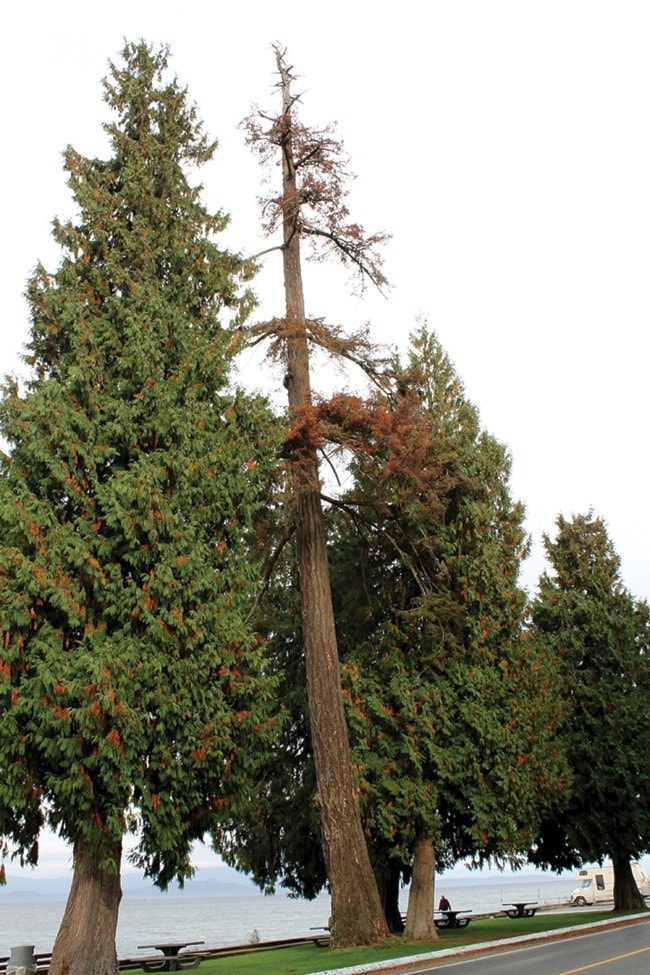Qualicum Beach is cutting a well known eagle tree on the waterfront, but what is an "eagle tree"?
"A significant amount of rot has traveled up this tree to a height of 15 to 20 metres," which is most of the tree, director of planning Luke Sales explained to town council Monday night, introducing a requested arborist's report on the dead tree near The Beach Hut.
"The tree essentially looks like a donut," he said referencing the report by Julian Dunster of Dunster & Associates.
"In effect the tree is very hollow with only a thin shell of sound wood on the outside," states the report, which details that the tree has been dead for some time, likely from a "very well established phaeolus infection"
For a tree to have special protection as an eagle tree, it has to be a nesting tree. While perch trees, like the one on Qualicum Beach, may enjoy special status to onlookers, birders and eagles, the places where eagles like to hang out are not officially recognized.
"Eagle nest trees are automatically protected by provincial law," said Sales. "You are not allowed to cut them down or do certain activities near them. There are a lot of restrictions."
He said there isn't any formal process for designating nest trees. It's as simple as whether they have a nest in them.
And you wouldn't miss an eagle nest since they can be two metres wide and weigh 500 kg — they are rather easy-to-see structures, of which there are only a couple within town boundaries.
The B.C. Wildlife Act makes it an offence for anyone who "possesses, takes, injures, molests or destroys any tree with the nest of an eagle, peregrine falcon, gyrfalcon, osprey, heron or burrowing owl," or any other currently occupied bird nest.
"The evidence is right there in those cases, but this tree is not a nest tree," Sales explained of the dead Douglas fir tree in question, which he estimated at 300-400 years old.
Dunster used arbotom sonic tomography equipment to get a cross section image of the trunk 30 cm off the ground and found just a few centimetres of wood, compared to the normal 15-20 cm a tree that size should have.
Sales told council Dunster provided two recommendations: remove the tree, or cut it down to around six metres, leaving a natural feature that wildlife could use.
"Staff have consulted with the Ministry of Forest Lands and Natural Resources to verify it would still have ecological value," Sales said.
Sales said staff is leaning toward the six-metre option, and because it is a safety issue, something will be done.
Coun. Barry Avis suggested finding a way to honour the tree and talked about the territoriality of eagles and the importance of the tree.
"It has been a part of town for generations. It is well regarded by people who walk along that seawall walk, we think it is a significant tree," said Mayor Teunis Westbroek, who added that they want to make sure people know it's coming down and are not blindsided.
He also supported Avis's comment about helping people find closure, referencing a First Nation practice of allowing people to have a way to express their feelings for the tree.
"The town has put a lot of time and money into creating and protecting natural spaces, including waterways and habitat," Westbroek said, adding that nobody wants to cut it down, but "it is a natural part of life."
He said deferring any decision to March will allow the community to give input into "how to best bring closure."
Sales also pointed out that it has been a landmark throughout the town's history, and "it shows up in all kinds of photos at the museum."
Council will have another chance to address the issue at their March 2 regular meeting. After that meeting, because of the internal rot, a crew will have to cut it to about six metres and see what it looks like at that point and then decide whether to leave it there or remove it completely.
The report states: "This approach would create a very useful wildlife tree. It should last in reasonably stable condition for at least a decade," and recommends re-checking it at least every other year.
